IndiGo may add premium seats and depart the low-cost model
The Indian low-cost airline, IndiGo, has announced that it is considering the possibility of introducing premium seats on some of its international routes. The introduction of the premium cabin aims to attract customers with higher purchasing power. Passengers choosing these seats can expect benefits such as priority boarding, complimentary meals, and greater flexibility for itinerary changes.
IndiGo plans to incorporate the Airbus A321 XLR into its fleet from 2025. These long-range aircraft will enable the airline to enter European markets. These planes will feature business class seats and more legroom in the economy class, accommodating 190 passengers. Pieter Elbers, CEO of IndiGo, supports the introduction of the two-class cabin, emphasizing the dynamic nature of the market and the need for flexibility. Despite the highly competitive pricing in the Indian market, according to Elbers, the airline is always «evaluating available options.» This move towards establishing a premium section is seen as a strategic opportunity for IndiGo to attract high-end travelers.
As the largest airline in Asia in terms of capacity, IndiGo made the largest order in history at the Paris Air Show by signing an agreement to purchase 500 aircraft from the Airbus A320 family, ensuring a steady flow of deliveries between 2030 and 2035. Currently operating more than 300 aircraft with previous orders for 480 yet to be delivered, this additional order brings IndiGo’s portfolio to almost 1,000 aircraft awaiting delivery well into the next decade.
Balancing Affordability and Quality
However, industry analysts and investors are closely monitoring this strategic shift. They have expressed caution regarding the airline’s ability to keep unit costs low while simultaneously offering a premium product without compromising its business strategy. The consulting firm CAPA has added its reservations, emphasizing the risks associated with overestimating premium traffic and potential hurdles of hybridization for low-cost airlines.


Para comentar, debés estar registradoPor favor, iniciá sesión